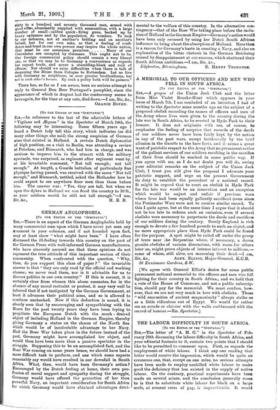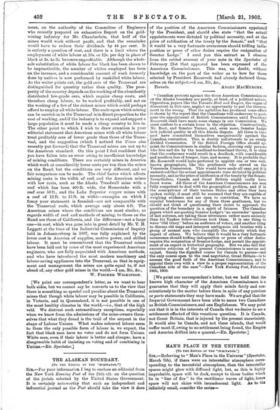THE LABOUR DIFFICULTY IN SOUTH AFRICA. [To THE EDITOR OF
TEE "SPECTATOR."] Sin,—The letter of "A. M. G." in the Spectator of Feb. ruary 28th discussing the labour difficulty in South Africa, and your editorial footnote to it, contain two points that I should like to be permitted to comment upon. First, as regards the employment of white labour. I think any one reading that letter would receive the impression, which would be quite an erroneous one, that, except on one mine, no serious attempts have been made to employ unskilled white labour to make good the deficiency that has existed in the supply of native labour. On the contrary, practical experiments have been made on several mines, and the conclusion generally come to is that to substitute white labour for black on a large scale, at present rates of pay, is impracticable. It would mean, on the authority of the Committee of Engineers who recently prepared an exhaustive Report on the gold- mining industry for Mr. Chamberlain, that half of the mines would work without profit, and that the remainder would have to reduce their dividends by 44 per cent. It is entirely a question of cost, and there is a limit where the employment of white labour at 10s. or 12s. per day in place of black at 2s. to 3s. becomes unprofitable. Although the whole- sale substitution of white labour for black has been shown to be impiacticable, the number of whites employed has been on the increase, and a considerable amount of work formerly done by natives is now performed by unskilled white labour. As the writer points out, the gold ores of the Transvaal are distinguished for quantity rather than quality. The pros- perity of the country depends on the working of the abundantly distributed loiv-grade ores, which require cheap costs, and therefore cheap labour, to be worked profitably, and not on the working of a few of the richest mines which could perhaps afford to employ all white labour. The scale upon which mining can be carried on in the Transvaal is in direct proportion to the cost of working, and if the industry is to expand and support a large population it must be made a cheap country to live in. The other point to which I wish to draw attention is your editorial statement that American mines with all white labour treat profitably ores of lower grade than those of the Trans- vaal, and the suggestion (which I noticed the Times also recently put forward) that the Transvaal mines are not up to the American standard. On this point I feel confident that you have fallen into an error owing to insufficient knowledge of mining conditions. There are certainly mines in America which work at considerably lower costs per ton than the mines on the Rand, but the conditions are very different, and no fair comparison can be made. The chief factor which affects mining costs is the width of reef, and the American mines with low costs, such as the Alaska Treadwell mine with a reef which has been 400 ft. wide, the Homestake with a reef over 50 ft., and the Lake Superior copper mines with a reef of 12 ft. to 15 ft. in width—examples on which I fancy your statement is founded—are not comparable with the Transvaal reefs, which average only about 4 ft. The American mines where the conditions are most similar, as regards width of reef and methods of mining, to those on the Rand are those of California, and the difference—not alarge one—in cost, which was gone into in great detail by Mr. T. H. Leggett at the time of the Industrial Commission of Inquiry held in Johannesburg in 1897, was fully explained by the lower cost in America of supplies, motive power, and skilled labour. It must be remembered that the Transvaal mines have been laid out by some of the most experienced American engineers, who are fully acquainted with American methods, and who have introduced the most modern machinery and labour-saving appliances into the Transvaal, so that in equip- ment and management the mines are quite equal to, if not ahead of, any other gold mines in the world.—I am, Sir, &c.,
W. FISCHER WILKINSON.
[We print our correspondent's letter, as we want to hear both sides, but we cannot say he converts us to the view that there is something so special and peculiar about the Transvaal mines that though white labour may be possible in California, in Victoria, and in Queensland, it is not possible in one of the most healthy climates in the world,—i.e., that of the high veld. We distrust such extraordinary exceptions, especially when we know from the admissions of the mine-owners them- selves that what they dread is the trail of the serpent in the shape of Labour Unions. What makes coloured labour seem to them the only possible form of labour is, we expect, the fact that black men have no votes and do not form Unions. White men, even if their labour is better and cheaper, have a disagreeable habit of insisting on voting and of combining in Unions.—En. Spectator.]











































 Previous page
Previous page